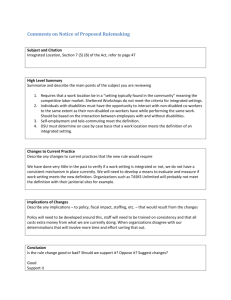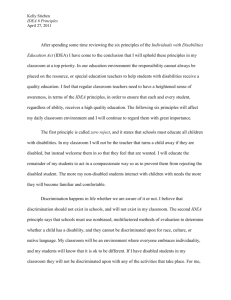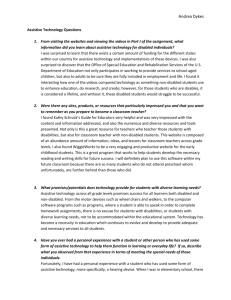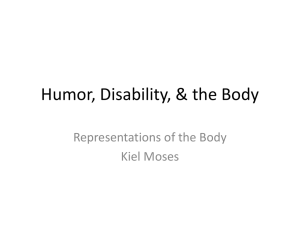Gsp_1 (1)
advertisement
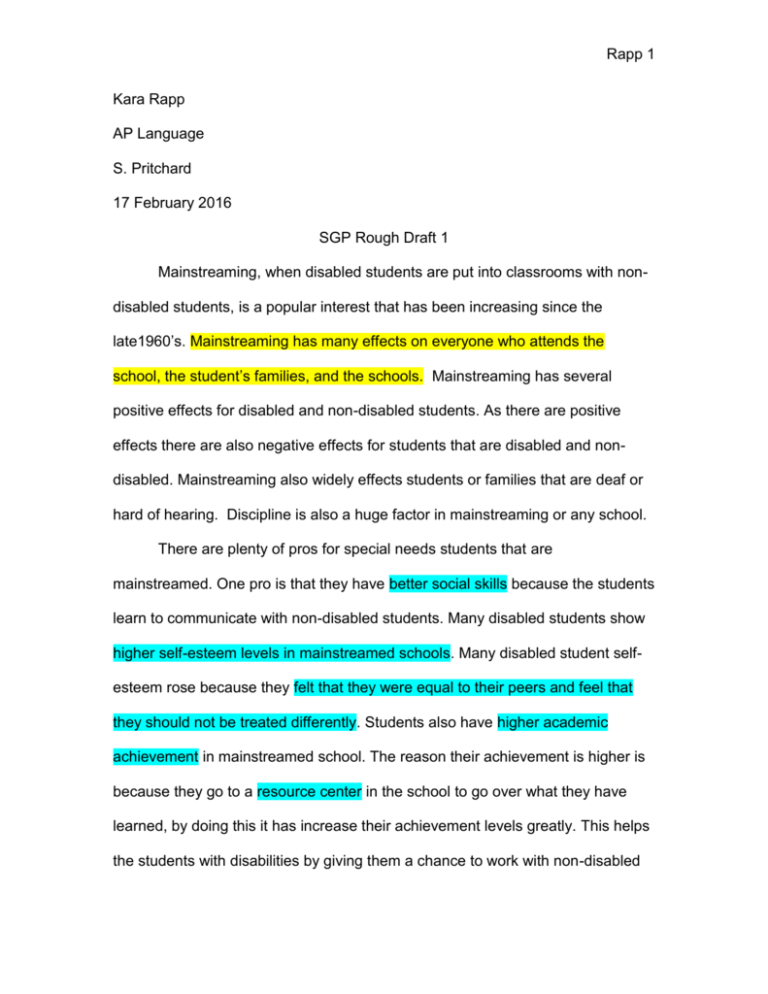
Rapp 1 Kara Rapp AP Language S. Pritchard 17 February 2016 SGP Rough Draft 1 Mainstreaming, when disabled students are put into classrooms with nondisabled students, is a popular interest that has been increasing since the late1960’s. Mainstreaming has many effects on everyone who attends the school, the student’s families, and the schools. Mainstreaming has several positive effects for disabled and non-disabled students. As there are positive effects there are also negative effects for students that are disabled and nondisabled. Mainstreaming also widely effects students or families that are deaf or hard of hearing. Discipline is also a huge factor in mainstreaming or any school. There are plenty of pros for special needs students that are mainstreamed. One pro is that they have better social skills because the students learn to communicate with non-disabled students. Many disabled students show higher self-esteem levels in mainstreamed schools. Many disabled student selfesteem rose because they felt that they were equal to their peers and feel that they should not be treated differently. Students also have higher academic achievement in mainstreamed school. The reason their achievement is higher is because they go to a resource center in the school to go over what they have learned, by doing this it has increase their achievement levels greatly. This helps the students with disabilities by giving them a chance to work with non-disabled Rapp 2 students and then later on they can go to a resource room to work on and go over anything that they did not understand or need extra help on. The resource room allows provides a place where students with disabilities can go if they are having behavior or problems in class. These are all examples of how mainstream disabled students have positive effects. Even with the positive effects there are also negative effects for students with disabilities. There are several negative effects to students with disabilities in mainstreamed schools. Not every disabled student may do well in mainstreamed classes. Some students may not feel comfortable in classes with non-disabled students or they may not get they need because the teacher is not trained to have disabled students. Disabled students may become targets for bullying because they are different then other students. Students may also feel socially rejected by their classmate, because they need extra help in the class or they might have a hard time socializing with the other students. Students also may feel embarrassed by any extra help they get because none of the other students need it. Disabled children may also get easily frustrated because they do not understand or cannot do the work as quickly as the other students. Careful attention must be given to combinations of students with special needs because not all disabilities combine well together. These are a few negative effects for disabled students. Mainstreaming benefits are also available to non-disabled students as well. Non-disabled students benefit from classes with students that have disabilities. For non-disabled students it helps them to gain tolerance and self Rapp 3 worth, because the disabled student may have trouble with their social skill, so the child will gain tolerance to disabled students needs. Learning tolerance and self worth will help the child learn what to do in a future situation. This also prepares students for the outside world. They will be more prepared and knowing of people who may have special needs. This also allows the students to create an understanding atmosphere, which is also preparing themselves for the world beyond on the schools. These are some positive effects and there are plenty more. There are also negative effects for non-disabled students that are mainstreamed with students with special needs. There are several cons that also effect teachers, the parents of the students, the students, and the school. The students may not get enough attention or help from the teacher because the students with disabilities need extra help. Those students that are not getting the help they will not have as high academic achievement as they could have if they got the help they needed. Not all teachers have the training to work with students with special needs. The teachers may not know how to adapt their classroom to fit all the needs of the class including the needs of the children with disabilities. Cost is another effect that can be a huge disadvantage. The school may not be given additional financial aid for the resources and the cost for the equipment for students that are disabled can be very expensive. The school may also pay for the students with special needs to have an assistant to help the student and this will cost the school more money. Students with many disabilities being mainstreamed means the school will have to spend more money to meet their needs. There are other Rapp 4 negative effects but these are some of the main ones. Other effects that must be closely considered are effects that deal with student that have any hearing impairment including being deaf, hard of hearing, or has any issues with hearing. There are several effects to mainstreaming when it comes to students that are deaf or have hearing impairments. They usually have good academic results .Students that are deaf may have many social issues in a mainstream school because most of them speak using their hands instead of words. How comfortable they are in a mainstream school depends on the on the therapy they receive. Few people in mainstream school know sign language which creates a communication barrier. Since there are often communication barriers deaf students usually have higher degrees of isolation and psychological problems in mainstreamed schools. They also may have difficulty in making friends which leads to isolation as well as low self-esteem. Deaf students may also have a harder time learning and or following instructions. They can only learn what is directly communicated to them which often leaves gaps in knowledge and can be dangerous to their academic and social interactions. Students that are deaf may closely watch your mouth and body language to try to understand you. They also may watch what the other kids are doing so can know what to do. Many people are also afraid that deaf students in mainstreamed schools will affect the Deaf culture. There not many Deaf communities and school that traditions, stories, and values developed that the same settings cannot be duplicated in a mainstream setting. This also leads to a fear that the deaf community will be weaken. These Rapp 5 effects need to be considering before mainstreaming. Discipline is a major factor that you must decide what will happen. Discipline is in every school mainstreamed or not. Discipline must be practiced and you must follow through with it. Students will think it is ok to continue breaking the rules if you do not follow through. Teacher needs to have their classrooms set so they can be ready for any situation that happens. Negative reinforcement will not teach the student what you want. Using positive reinforcement is the best way. Discipline is a major role in any school. This is how mainstreaming effects everyone in the community. There are many pros to mainstreaming with students that are disabled and for students that are non-disabled. As there are pros there are also several cons for students that are disabled and that are not disabled, teachers, parents, and even the school. There are several effects for deaf students that must be looked at before mainstreaming the student or not. Discipline plays a big role in all schools and is needed to be enforced. Citations: Rapp 6 Kathy, Flores. “Special need, ‘mainstream classroom” Children.org. JanuaryFebruary 2003: no pagination. Web. 11/3/2011. “Mainstreaming (Education)” Wikipedia.org. 9/25/2011: no pagination. Web. 11/3/2011. “Special needs education within the education system - Denmark” Europeanangency.org. March 26, 2010: no pagination. Web. 11/3/2011. “How to teach students with learning disabilities in a mainstream class”. Ehow.com.10/05/11: no pagination. Web. 11/3/2011. George, Waston. Classroom Discipline Problem Solver. New York: West Nyack, 1998. Print. Goldstein, Sam. It’s Just Attention Disorder. Utah: Neurology, Learning and Behavior Center, 1991. print.

